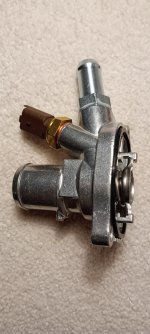Pepandaros
Member
I recently bought my second Panda and it's a 1.2 from 2011.
The radiator is leaking so I have a replacement on order, also going to replace the metal tube and the thermostat whilst I'm at it.
The thermostat has arrived today and unlike my 1.1 this one has the the o-ring groove in the casting. It doesn't seem right to me as the rubber seal sticks out quite a bit I wonder if it would compress enough to make the both surfaces mate. As it's sort of moulding square o-ring I might struggle to find a thinner O-ring.
Some thoughts if I should use this or just return it and order a different brand?
The radiator is leaking so I have a replacement on order, also going to replace the metal tube and the thermostat whilst I'm at it.
The thermostat has arrived today and unlike my 1.1 this one has the the o-ring groove in the casting. It doesn't seem right to me as the rubber seal sticks out quite a bit I wonder if it would compress enough to make the both surfaces mate. As it's sort of moulding square o-ring I might struggle to find a thinner O-ring.
Some thoughts if I should use this or just return it and order a different brand?


